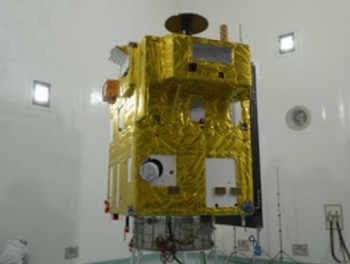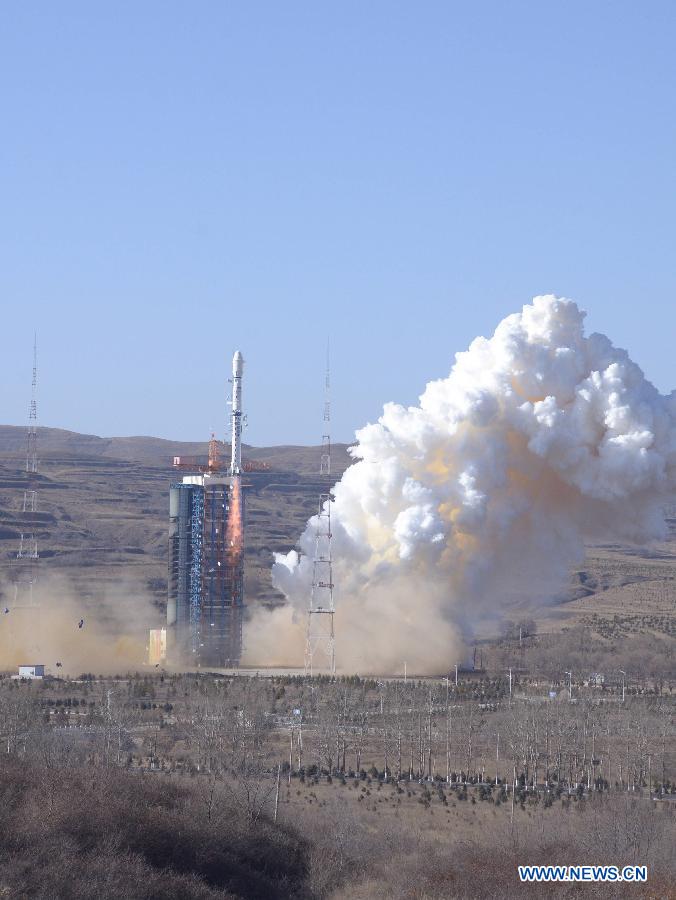.


he fifth cooperative mission between China and Brazil was launched at 03:26UTC on Sunday. In what was a milestone 200th launch for the Chinese rocket fleet, the CBERS-4 satellite was lofted by China’s Long March-4B from the LC9 launch complex at the Taiyuan Satellite Launch Center.
CBERS Program:
CBERS (China-Brazil Earth Resources Satellite) is a cooperative program of China and Brazil.
In November 2002, the governments of China and Brazil decided to expand the initial agreement by including another two satellites – CBERS-3, lost in a launch mishap in December 2013, and CBERS-4 – as the second generation of the Sino-Brazilian cooperation effort.
The planned cooperative program of CAST and INPE employs enhanced versions of spacecraft and instruments. The specifications of the project were agreed upon and completed in July 2004.
In China, the CBERS satellites are referred to as Ziyuan-1 (“Resource-1″). The agreement for the development of first generation satellites was signed in July 1988 to establish a complete remote sensing system (space and ground segment) to supply both countries with multi-spectral remotely sensed imagery.
The overall objective is the observation and monitoring of the Earth’s resources and environment with a multi-sensor imaging payload providing different spatial resolutions.
The CBERS-1 ‘Ziyuan-1A’ (25940 1999-057A) spacecraft was launched at 0316UTC on October 14, 1999 by the Long March (Y1) launch vehicle from Taiyuan’s LC7 Launch Complex. CBERS-1 operated until August 2003.
CBERS-2 ‘Ziyuan-1B’ (28057 2003-049A) was launched at 0316UTC on October 21, 2003 by the Long March (Y4) also from Taiyuan’s LC7 launch complex. The spacecraft was retired in late 2007 when imagery from CBERS-2B was available.
CBERS-2B ‘Ziyua-1B2′ was launched at 0326UTC on September 19, 2007 by the Long March (Y17) launch vehicle from the Taiyuan’s LC7 launch complex. CBERS-2B was retired on May 10, 2010 due to a power failure.
CBERS-3 was launched on December 9, 2013, by the Long March (Y10) from Taiyuan’s LC9 launch complex.
In 2004, Brazil changed its CBERS data distribution and access policies.
With CBERS-2, Brazil adopted an open data distribution policy, ensuring free access through the internet to its catalogue and to full resolution images.
The same policy was adopted for CBERS-2B and will also be adopted for the new satellite. The policy was also extended to neighboring countries under the footprint of the Cuiaba-Brazil ground station and archived at INPE’s catalog.
CBERS-4:
CBERS-4 – with a mass of 1,980 kg – will operate on a sun-synchronous orbit at 778 km altitude with an inclination of 98.504 deg and 100.26-minute orbital period. This orbit has a repeat cycle of 26 days.
The launch of CBERS-4 was originally scheduled for December 2015. However, due to the loss of CBERS-3, China and Brazil agreed to anticipate the launch one year.
The spacecraft consists of a hexahedron shaped structure divided in service and payload modules. In the orbital configuration, the Z axis is pointed to the Earth’s surface. The cameras and antennas are mounted on the +Z side panel. The solar panel is mounted on the -Y side panel and rotates around the Y axis.
The antennas, thrusters and attitude sensors – such as sun sensors and infrared Earth sensors – are mounted on other panels.
The spacecraft is 3-axis stabilized keeping the imager pointed toward nadir. The AOCS (Attitude and Orbit Control Subsystem) includes sensors, gyros, GPS receiver, a control computer, momentum wheels and a hydrazine propulsion system.
Thermal control is achieved mainly by passive means using thermal coating and multi-layer insulation blankets. Heat pipes and heaters are also used. The EPS (Electrical Power Subsystem) uses triple-junction GaAs solar panels, a shunt regulator, battery charge control, a battery discharge regulator, DC/DC converters and NiCd (Nickel Cadmium) batteries. The EPS can provide 2.30 kW to the spacecraft.
The nominal payload capability of the platform is 1,000 kg; the mass of the entire spacecraft is 1,980 kg. In its launch configuration, the dimensions are: 2.5 x 2.0 x 1.8 m. Solar panel dimensions are 6.3 x 2.6 m.
The OBDH (On-Board Data Handling) subsystem consists of a main computer and 7 remote terminal units to provide onboard data handling and the spacecraft monitoring and control functions. The S-band is used for the TT&C functions providing two-way communications with the ground. The S-band antenna offers a near omni-directional coverage.
The payload image data is downlinked in X-band by two TWTA transmitters. One of them has three carriers modulated in QPSK (Quadra-Phase Shift Keying): The on-board recorder has a capacity of 274 Gbit, and is capable of recordoing data from all cameras.
CBERS-4 carries four cameras in the payload module, with improved geometrical and radiometric performance (MUXCam, PanMUX, IRS and WFI).
MUXCam is an INPE instrument designed and developed at Opto Eletrônica S. A., of São Carlos, São Paulo, Brazil. The objective is to provide imagery for cartographic applications. MUXCam is a multispectral camera with four spectral bands covering the wavelength range from blue to near infrared (from 450 nm to 890 nm) with a ground resolution of 20 m and a ground swath width of 120 km.
The MUXCam instrument consists of three devices: RBNA, RBNB and RBNC. The RBNA provides image acquisition and is composed of the optical system (entrance mirror and lens assembly), optical housing and the focal plane assembly.
The RBNC subsystem is responsible for generating the CCD reading clocks, processing the CCD analog outputs to a digital signal, and then encoding the signal into a serial data stream. This data is transmitted to the satellite.
The CCD detector is a 4-line array, each line having 6000 pixels of size: 13 µm x 13 µm. Spectral thin films, deposited over a window that covers the photosensitive elements of the CCD, are responsible for the separation of the four spectral bands.
Provided by China, the PanMUX (Panchromatic and Multispectral Camera) is a CCD pushbroom camera that provides panchromatic images with 5m GSD (Ground Sample Distance) and three band multispectral images with 10 m GSD.
The camera has a swath width of 60 km and a side-viewing capability of ±32º. The PanMUX has focal plane adjustment and on-orbit calibration capabilities.
Also provided by China and developed on the heritage of the Infrared Multispectral Scanner used on previous missions, the IRS (Infrared System) or IRMSS-2 (Infrared Multispectral Scanner-2) is an imager with 4 spectral bands. The spatial resolution is halved with regard to IRMSS.

The WFI (Wide-Field Imager) (also referred to as WFI-2) is an advanced version of the INPE instrument flown on CBERS-1, and CBERS-2, featuring 4 spectral bands with a ground resolution of 64 m at nadir and a ground swath of 866 km.
The WFI instrument on CBERS-4 provides also an improved spatial resolution in comparison with the previous WFI sensors on board of the CBERS-1 and CBERS-2 satellites (260 m on previous missions), maintaining, however, its high temporal resolution of 5 days.
This camera will be used for remote sensing of the Earth and it is aimed to work at an altitude of 778 km. The optical system is designed for four spectral bands covering the range of wavelengths from blue to near infrared and its FOV (Field of View) is ±28.63º, which covers 866 km, with a ground resolution of 64 m at nadir.
WFI has been developed through a consortium formed by Opto Electrônica S. A. and Equatorial Sistemas. The optical system development and the performance analyses (including optical system MTF, distortion, polarization sensitivity and stray-light) was executed using ZEMAX software.
Beside the cameras, CBERS-4 will have the DCS (Data Collection System) and the SEM (Space Environment Monitor). The DCS is provided by INPE and the SEM is provided by CAST (Chinese Academy of Space Technology).

Launch vehicle and launch site:
The feasibility study of the Chang Zheng-4 began in 1982 based on the Feng Bao-1 launch vehicle. Engineering development was initiated in the following year. Initially, the Chang Zheng-4 served as a back-up launch vehicle for Chang Zheng-3 to launch China’s communications satellites.
After the successful launch of China’s first DFH-2 communications satellites by Chang Zheng-3, the main mission of the Chang Zheng-4 was shifted to launch sun-synchronous orbit meteorological satellites. On other hand, the Chang Zheng-4B launch vehicle was first introduced in May 1999 and also developed by the Shanghai Academy of Space Flight Technology (SAST), based on the Chang Zheng-4.
The rocket is capable of launching a 2,800 kg satellite into low Earth orbit, developing 2,971 kN at launch. With a mass of 248,470 kg, the CZ-4B is 45.58 meters long and has a diameter of 3.35 meters.
SAST began to develop the Chang Zheng-4B in February 1989. Originally, it was scheduled to be commissioned in 1997, but the first launch didn’t take place until late 1999. The modifications introduced on the Chang Zheng-4B included a larger satellite fairing and the replacement of the original mechanical-electrical control on the Chang Zheng-4 with an electronic control.
Other modifications include improved telemetry, tracking, control, and self-destruction systems with smaller size and lighter weight; a revised nozzle design in the second stage for better high-altitude performance; a propellant management system for the second stage to reduce the spare propellant amount, thus increasing the vehicle’s payload capability; and a propellant jettison system on the third-stage.
The first stage has a 24.65 meter length with a 3.35 meter diameter, consuming 183,340 kg of N2O4/UDMH (gross mass of first stage is 193.330 kg). The vehicle is equipped with a YF-21B engine capable of a ground thrust of 2,971 kN and a ground specific impulse of 2,550 Ns/kg. The second stage has a 10.40 meter length with a 3.35 meter diameter and 38,326 kg, consuming 35,374 kg of N2O4/UDMH.
The vehicle is equipped with a YF-22B main engine capable of a vacuum thrust of 742 kN and four YF-23B vernier engines with a vacuum thrust of 47.1 kN (specific impulses of 2,922 Ns/kg and 2,834 Ns/kg, respectively).
The third stage has a 4.93 meter length with a 2.9 meter diameter, consuming 12,814 kg of N2O4/UDMH. Having a gross mass of 14,560 kg, it is equipped with a YF-40 engine capable of a vacuum thrust of 100.8 kN and a specific impulse in vacuum of 2,971 Ns/kg.
This was the 213th orbital launch by China, also being the 201st successful Chinese orbital launch, the 50th successful launch from Taiyuan, the 13th orbital launch by China in 2014 and the 5th from Taiyuan. Notably, it was the 200th Long March launch.
Situated in the Kelan County in the northwest part of the Shanxi Province, the Taiyuan Satellite Launch Center (TSLC) is also known by the Wuzhai designation. It is used mainly for polar launches (meteorological, Earth resources and scientific satellites).

The launch center has two single-pad launch complexes, a technical area for rocket and spacecraft preparations, a communications centre, a mission command and control centre, and a space tracking centre.
The stages of the rocket were transported to the launch centre by railway, and offloaded at a transit station south of the launch complex. They were then transported by road to the technical area for checkout procedures.
The launch vehicles were assembled on the launch pad by using a crane at the top of the umbilical tower to hoist each stage of the vehicle in place. Satellites were airlifted to the Taiyuan Wusu Airport about 300km away, and then transported to the centre by road.
The TT&C Centre, also known as Lüliang Command Post, is headquartered in the city of Taiyuan, It has four subordinate radar tracking stations in Yangqu (Shanxi), Lishi (Shanxi), Yulin (Shaanxi), and Hancheng (Shaanxi).
Quelle: NS
.

4066 Views
